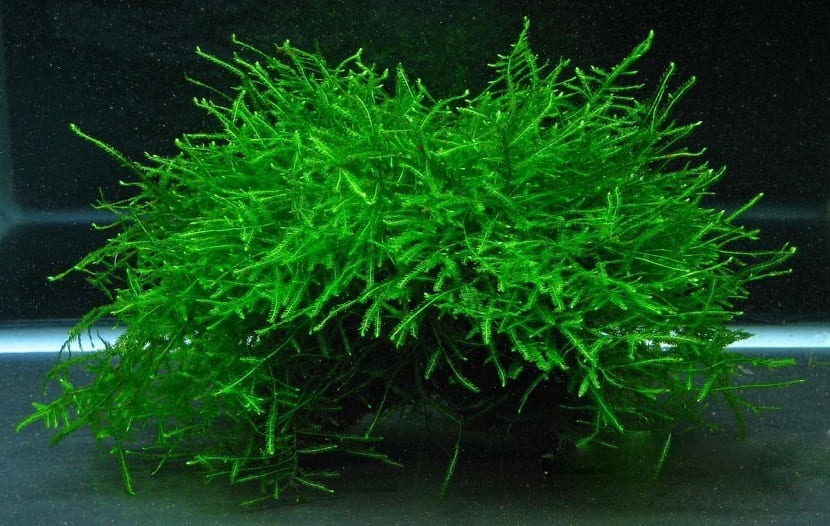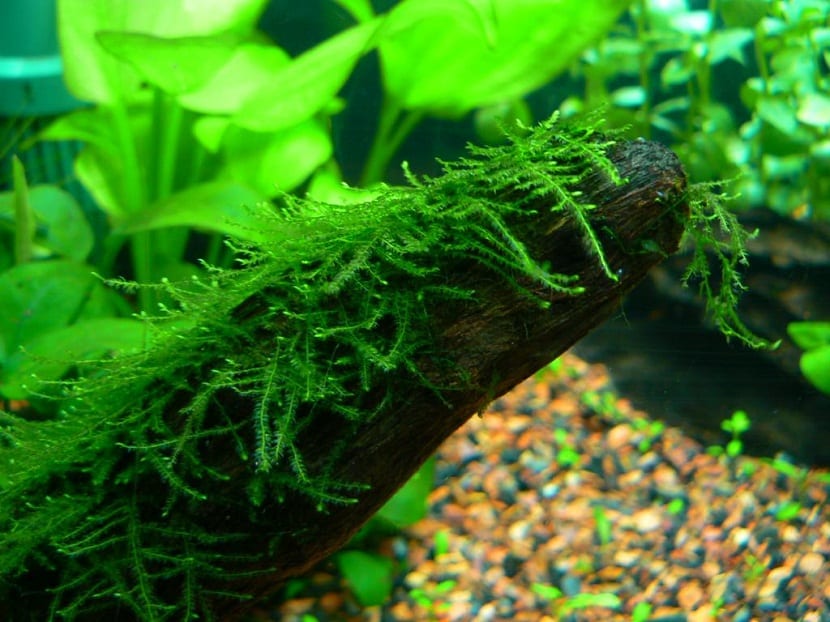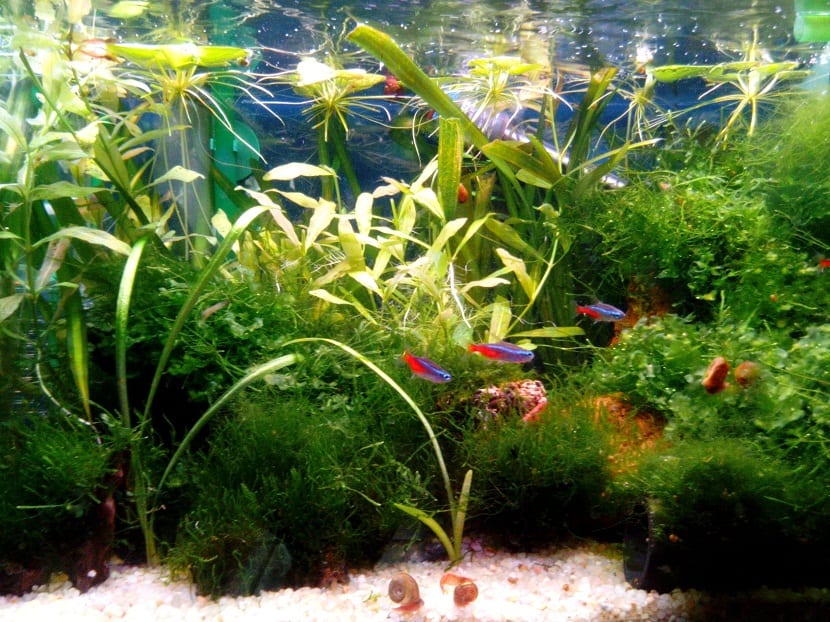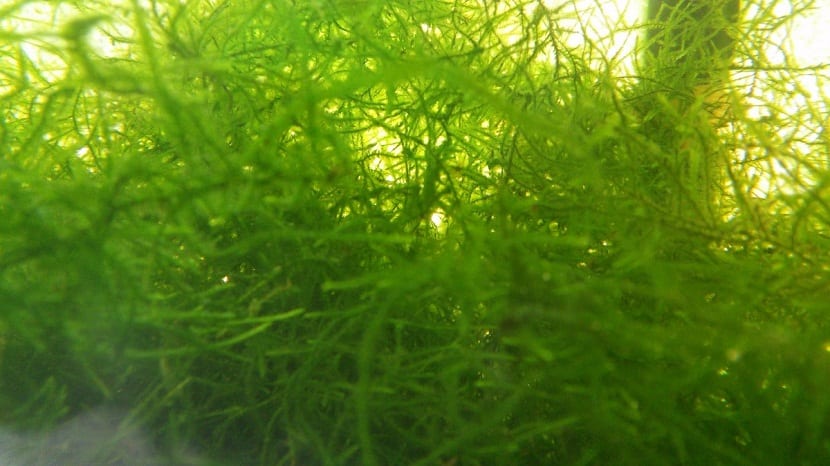
Java moss, whose scientific name is Vesicularia Dubya, is one of the most commonly used plants in aquariums. The preference of amateurs, both beginners and experts, for this moss is essentially due to its appearance, usefulness, easy cultivation and maintenance.
Java moss provides excellent shelter for fingerlings. What's more, This foam is very well suited to any type of fish tank and does not require major maintenance; it is preserved in fresh water and does not need special lighting, to such an extent that the natural light in the room is sufficient.
Origin of Java moss

Java moss is an aquatic plant belonging to the Hypnaceae family and has its origin in Southeast Asia, regions such as the island of Java from which it derives its name, Japan, Malaysia, Vietnam, the Philippines and islands of the well-known eastern archipelago. Abundant in tropical climates and humid places. It can be seen equally on rocks, rivers, and trees.
Features
La Vesicularia Dubya It is a delicate plant that has very reduced stems, of irregular and branched shape, it has small oval leaves superimposed on each other, these reach a smaller size when they develop under water. Adheres to the surface through its rhizoids, uses stems and leaves to acquire nutrients.
About its scientific name we can say that although it is known as Vesicularia Dubya, was recently reclassified as Taxiphyllum barbieri, However, debate persists among specialists about its definitive name.
It uses rhizoids only to adhere to surfaces, since it acquires the nutrients using their stems and leaves. Another characteristic of Java moss is that it can be developed in different light conditionsHowever, low light is conducive to giving the moss a darker appearance, while high light gives way to a denser and more compact plant, but its excess makes it prone to develop algae that can be harmful to the moss. .
Maintenance and cleaning
The maintenance method can be done in various ways, however, you can let the moss grow wild, cutting it only when you think it is necessary or establishing its cut on a regular basis; for this, it is enough to use scissors to control its growth.
You can choose to let it grow quickly, just by placing it in the chosen place, without doing anything special, just trimming it when required. A curiosity of this plant is that when cut it does not float as it happens with other types of plants, but instead sinks into the pond.
As you can see, the maintenance and cleaning of Java moss does not take much of your time. It is an invasive moss that means that you only need to remove the excess from your aquarium. In the same way and to clean it, just place it under any type of cold water spout and then squeeze it as if it were a common sponge. Although it is true that this moss does not require much maintenance, it is recommended that you clean it regularly because due to its characteristics it has a great capacity to attract and retain all residues.
Excess moss can clog your aquarium filter and even spread throughout the space if you don't prune it regularly. If you allow the moss to grow too large, it can prevent the free flow of water to the other sections of the aquarium, which will cause it to turn brown and the plant to detach from the object to which it is attached.

An additional problem is the presence of algae in the pond because these are prone to develop in precarious conditions and intense light, when this occurs, the algae become difficult to eliminate, which It could lead you, in extreme case, to have to remove the moss and start the growing process all over again, which can result in wasted time and money.
To avoid the appearance of algae it is necessary to maintain the balance of three very important factors: light, carbon and nutrients for plantsOtherwise, this coupled with poor water conditions would stimulate the development and growth of algae. However, the presence of a small portion of algae in the aquarium can be beneficial to the aquatic ecosystem in general.
Its cultivation
For the cultivation of Java moss, the use of fresh and acidic water at a temperature below 30 ° C is recommended. At colder temperatures such as 24 ° you can achieve a cleaner development and a moss with a healthier and more vigorous face. Because care should be taken in the summer season, especially during intense heat. When the moss appears yellowish, it is a sign that the heat is affecting it negatively.
When it is placed inside the aquarium, it can take time for the moss to adapt to the conditions of the container, if that happens, do not worry if the plant does not show signs of recovery and growth. It is common for this to happen, it is just a natural process during which the moss adapts to the climatic conditions of the aquarium, it may take a month or a little more for this to happen. There are those who recommend the use of CO2 to accelerate their growth, but this is not necessary because they grow naturally without the need for it.
La Vesicularia Dubya It thrives easily on a variety of surfaces, adheres comfortably to wood, pond stones, and even decorations sold by specialist commercial houses. Equally, you can grow them in the back of the aquarium and thus recreate an impressive marine aspect full of plants. This moss helps to decontaminate the water, which reduces the need to change the water and prevents odors in the aquarium.
Uses

This moss is highly prized by aquarium hobbyists for a number of reasons. Some use java moss to improve the interior of aquariums, which sometimes do not look good. This is achieved by covering the sides of the pond (walls or floor), even up to the filter installations so that it gives a more natural and pleasant appearance. This moss can be found in most natural surfaces, streams or rivers, or simply in specialized stores.
Java moss is also very popular with lovers of aquascaping, which is a hobby where a kind of underwater garden is created in the aquarium or other type of pond, with aquatic species and other useful implements for this purpose, it may or may not contain fish. With the arrangement of moss next to stones and aquatic implements a beautiful marine environment is recreated. Likewise, java moss is used in ponds dedicated to the breeding of other species, since it protects the eggs and provides nutrients to the small fish.
The moss can attach its rhizoids to any arranged object for the best decoration of the aquarium and thus present a bonsai-like effect or stick to the pond floor to create the feel of grass.